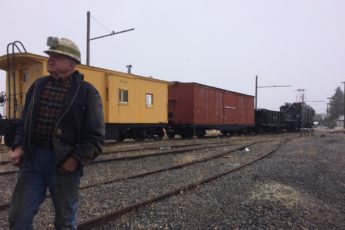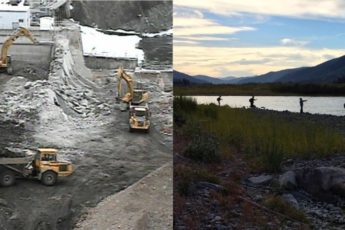But at Fish Creek State Park, Nature is Following its Own Development Plan
Summer means exploring our state, and at Prairie Populist we’re joining the thousands of Montanans visiting the amazing lands, lakes, and historical sites that make up Montana’s state parks. We hope you’ll check back all summer and join us as we explore what these parks mean for the people of our state and how they help make Montana a place unlike any other.
It’s quiet here. Really quiet. Fish Creek State Park and the surrounding wildlife management areas are in a regeneration phase since the Plum Creek Logging Company sold off 310,000 acres of its land to The Nature Conservancy (TNC) and Trust for Public Land in one of the largest land acquisitions in Montana history.
Known as the Montana Legacy Project — a rather ambitious initiative that looks at wildlife conservation on an ecosystem scale — the project aims to recognize both the intrinsic and the natural value of landscapes to rural communities across western Montana, while also increasing connectivity corridors for wildlife passing through these areas.
Plum Creek’s logging operation was a major economic driver for Fish Creek and the surrounding Mineral County. In addition to jobs and tax revenue, the land offered ample opportunity to hunt, hike, and fish. Concerned about the impact the sale would have on the economic viability of the area as well as access to recreational opportunities, many Montanans, especially Fish Creek locals, were skeptical of the project at first. However, when it comes to conservation, Montanans have a way of compromising with their neighbors.
“For decades, the public used that land as if it was their own . . . when in fact we had the corporate landowners to thank for that,” said Fish, Wildlife & Parks Regional Wildlife Manager Mike Thompson.
“We all took it somewhat for granted, so when the timber company pulled out . . .it posed a significant change of lifestyle.”
When the last of the three-part land deal went through in 2010, locals worried the land would be locked up under TNC ownership. They were also concerned they would lose the tax revenue the county generated from the logging operation — revenue necessary to maintain roads and other infrastructure. That’s when Montana Fish, Wildlife & Parks stepped in.
Montana Fish, Wildlife & Parks purchased 41,000 acres from TNC, turning 5,603 acres into Fish Creek State Park — the largest State Park in Western Montana — and converting the rest into a wildlife management area (WMA). Now, not only would the land remain open to both public access and critical habitat conservation initiatives, but the state would continue to pay property taxes to Mineral County.
The arrangement calmed initial concerns, but led to the next challenge: how best to manage, develop, and care for the land in a way that leverages its economic potential without threatening the still-fragile ecosystem. Still recovering from years of logging as well as a series of large forest fires, much of the area is in the early stages of regeneration.
A new era has yet to begin.
“The park and WMA (present) the opportunity for a tourism economy that is growing broadly,” said Thompson. “This has the potential to help Mineral County, but I’m not sure they have seen any of that yet.”
“For us, it’s challenging to manage such a large landscape,” said Chet Crowser, interim manager of the park. “It’s a neat place with some very valuable resources in terms for both wildlife and recreation. From a parks standpoint, we have more work than we typically do. The crux is how do we bring all these values together in a way where they do not detract from each other.”
Public comments on the draft management plan (released in 2014) offered up mixed opinion of what to do with the land. Several user groups advocated for more hiking and biking trails, but also placed a huge emphasis on wildlife conservation needs. Some folks hoped to see the 70-some miles of logging roads restored for OHV use, while others opposed motorized recreation. Thoughts on whether or not to add a campground and RV hookup were also split as comments weighed the pros of added revenue against the impact on wildlife in the park. A few comments went as far as to recommend the park remain primitive.
Several years later, the path forward remains tricky for Crowser — who is filling in for the previous park manager, who retired nearly a year ago — and his staff. In addition to digesting public input, several vacancies throughout the state park system are adding to the challenge.
“We aren’t really in a position to pick up these heavy lifts until we have some of those vacancies filled and some more support internally to move those projects forward,” explained Crowser.
Development plans may be on hold, but nature is not deterred. As the ecosystem continues to regenerate, it is forcing some projects to the top of the priority list.
Invasive weeds and deadfall are taking over many of the roads throughout the park, rendering several of them impassable, as other roads slowly erode back into the hillside. The longer these roads sit without care, the tougher it will be to regain access to certain parts of the park when a development plan does move forward.
A spectacular old fire tower rests on the peak of Mt. Williams deep inside the park. The site, if restored, would offer a unique camping opportunity. For now, the overgrown roads make it hard to get to the site and infrastructure damage leaves it closed to the public.
Erosion along the riverbed threatens campsites near the creek as well as the park’s natural attractions. The 350-year-old Big Pine, Montana’s largest ponderosa pine, sits dangerously close to the eroding riverbed. Park employees are doing the best they can to address the problem with the resources they have on hand.
“We haven’t had a normal capital or major maintenance fund or proceder fund for the last four or five years,” said Crowser, who noted that existing maintenance needs must take priority over development. “As we continue to have periods of time when we don’t have dollars, what we are often faced with is putting those development funds toward existing infrastructure that is in need of repair.”
As staff work in a triage fashion to address the most critical needs, the park, for the most part, remains dormant as wildlife takes over and the ecosystem regenerates. The hillsides are covered with a beautiful mosaic of first growth plant and shrub species, creating a brand new forest ecosystem. Elk, moose, and whitetail deer, in need of stable a habitat, are drawn to the chokecherry and serviceberry plants that are plentiful throughout the park.
“With the burn on top of what was harvested before, the landscape is just going to get better and better,” said Regional Wildlife Manager Thompson.
Fish Creek itself also remains in its natural state. An important resource for the area, Fish Creek’s headwaters are primarily roadless, allowing pristine, cold water to flow into the Clarks Fork, making it an important fishery.
Fish Creek
“It’s the most important Bull Trout fishery on the Clarks Fork watershed west of Missoula,” explained Thompson. “It’s really important to protect (the creek) for the perpetuation of native trout in Western Montana.”
Despite debate over what comes next, Fish Creek State Park is serving its original purpose: conserving wildlife while giving animals a safe corridor to travel between the Northern Rockies and the Bitterroot range.
“These are the key winter ranges for elk and deer, that’s the toughest time a year for those animals to survive and make it to the coming growing season,” explained Thompson. “(Fish Creek) as a watershed is a connectivity area for . . . all sorts of birds and mammals. When a grizzly bear moves around . . . (it) will show up in Fish Creek. If a wolverine moves around, it moves through Fish Creek.”
As the ecosystem thrives, addressing infrastructure needs and providing recreation opportunities remains a challenge — as does moving forward with any development plan for the 5,603-acres of Fish Creek State Park.
“In my view, we are not ready to have a proposal move forward,” said Crowser. “We need to go back to the drawing board and figure out how we are going to get from where we were previously to wherever we would head into the future.”
As land managers determine what to do next, nature is moving forward with its own development plan. Invasive weeds, overgrowth, and erosion will eventually require attention. In the interim, Crowser and his staff are working with the resources they have to conserve the area in a way that meets the needs of wildlife and humans alike.
Writing and Images By August Schield


